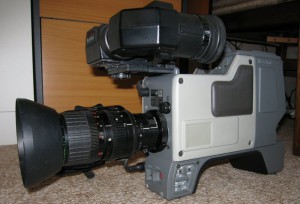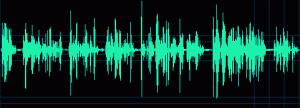Do your video depositions sound as good as they look?
We all know video depositions have become an ubiquitous litigator’s tool. Low cost HD cameras have become an ubiquitous legal videographer’s tool. The video quality of today’s depositions has never been better. But who is listening?
There was a time when very few depositions were taken by video. I digress and flashback to the 1980’s. When I got into the business the cost of entry was quite high and the quality of the cameras were very mediocre by today’s standards.  Decent video cameras cost $10,000 to $50,00o and up. They used image tubes instead of solid state CCDs and CMOS chips. The tubes required a lot of light to get a good picture. Not every location allowed videographers to light the witness properly. The video lights were bulky, took up floor space and were hot. Needless to say many video depositions back in the day were dark and grainy.
Decent video cameras cost $10,000 to $50,00o and up. They used image tubes instead of solid state CCDs and CMOS chips. The tubes required a lot of light to get a good picture. Not every location allowed videographers to light the witness properly. The video lights were bulky, took up floor space and were hot. Needless to say many video depositions back in the day were dark and grainy.
Oddly no one ever complained about the dark and grainy videos. Why not? The reason was the audio. The sound of the video saved the video depositions. No matter how badly the videos were lit the sound was always crystal clear. Our standard practice was to always record crystal clear audio no matter where we were shooting. We followed the rule: The better the sound, the better the video deposition looks. This golden rule is still true today but is overlooked by many legal video techs taking shortcuts.
 In 2013 the cost of entry into the business is extremely low yet the quality of camcorders is extremely high. Quality is so high that even the cheapest cameras found at WalMart have image quality specs that far exceed the $50,000 broadcast cameras of yesteryear. Back in the ’80’s no one imagined cameras could ever be so good and be so ridiculously inexpensive. But depositions are plagued with poor audio despite using modern digital recording equipment. Many depos from around the country pass through our editing and post production studio. We hear a lot of bad audio. Static, buzz and excessive background noise are the most common audio problems. These are problems that are easily avoided with a little know how and attention to detail. The basic principles of sound recording are the same today as they were back in the 80’s. State of the art digital recording gear is only as good as the technician operating it. Legal videographers must take responsibility for microphone placement, avoiding ground loop hum, preventing buzz, minimizing background noise and monitoring gain on each microphone. At your next video depo don’t over estimate the videographer’s fancy new gear. It may not sound as good as it looks.
In 2013 the cost of entry into the business is extremely low yet the quality of camcorders is extremely high. Quality is so high that even the cheapest cameras found at WalMart have image quality specs that far exceed the $50,000 broadcast cameras of yesteryear. Back in the ’80’s no one imagined cameras could ever be so good and be so ridiculously inexpensive. But depositions are plagued with poor audio despite using modern digital recording equipment. Many depos from around the country pass through our editing and post production studio. We hear a lot of bad audio. Static, buzz and excessive background noise are the most common audio problems. These are problems that are easily avoided with a little know how and attention to detail. The basic principles of sound recording are the same today as they were back in the 80’s. State of the art digital recording gear is only as good as the technician operating it. Legal videographers must take responsibility for microphone placement, avoiding ground loop hum, preventing buzz, minimizing background noise and monitoring gain on each microphone. At your next video depo don’t over estimate the videographer’s fancy new gear. It may not sound as good as it looks.